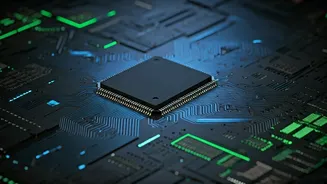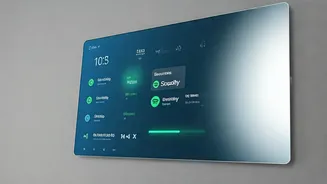Smart Mirror Concept
The genesis of the smart mirror began with an engineer's desire to integrate technology seamlessly into daily life. Inspired by the vision of a digital
hub that presents information at a glance, the engineer embarked on this project. The primary goal was to create a functional device that could display essential data like the time, music from Spotify, calendar events, and current news updates. The project's scope centered around affordability and accessibility, with the ambitious target of completing the build for approximately ₹5,000. This involved careful selection of components, strategic resourcefulness, and a focus on simplicity to make the project replicable for others interested in similar DIY endeavors. The motivation behind this endeavor was to not only enhance personal convenience, but also to explore the possibilities of merging technology with everyday objects in a creative, user-friendly manner.
Essential Components
Building the smart mirror required several key components, each playing a crucial role in its overall functionality. Central to the project was a display screen, serving as the visual interface to present information to the user. Alongside this, a single-board computer, likely a Raspberry Pi or similar device, acted as the brain of the mirror, processing and displaying the various data streams. The engineer also incorporated a two-way mirror, a special type of glass that allows light to pass through from one side while appearing reflective from the other, thus creating the illusion of a normal mirror when the display is off. Software played a pivotal role in this project, with applications developed to integrate the time, calendar, Spotify, and news feeds into a unified display. The cost was carefully managed, selecting cost-effective components to meet the ₹5,000 budget. This involved balancing functionality with price, ensuring the final product delivered an efficient yet affordable experience.
Software Integration Details
The software integration phase was critical to the smart mirror’s functionality, blending various data sources into a unified interface. The system was designed to pull data from multiple sources. Timekeeping was likely managed with a standard system clock, while calendar events were probably synchronized using an online calendar service like Google Calendar. Music was controlled through Spotify’s API, enabling playback and control directly from the mirror’s interface. News was aggregated using news APIs, allowing for dynamic display of headlines and updates. The development process focused on creating a user-friendly experience, with an intuitive layout that arranged the different data streams in an easily digestible manner. Emphasis was placed on ensuring smooth and regular data updates, providing users with the most current information. The software had to be designed to run continuously, seamlessly transitioning between different information displays to present a complete and useful view for the user.
Assembly and Design
The construction of the smart mirror involved several practical steps that combined technology with aesthetics. The initial phase focused on assembling the frame, which housed all the internal components. The engineer would have ensured the display screen and the two-way mirror were properly aligned within the frame, ensuring an unobstructed view. Installing the internal hardware—the single-board computer and any necessary wiring—required careful attention to detail for efficient functionality. The software needed to be loaded and configured on the single-board computer, with a series of tests to ensure everything ran properly. The design of the exterior was probably simple, clean, and modern. This design choice kept the focus on the digital display and functionality of the mirror. After all the components were assembled, the engineer would have checked the mirror’s software and hardware to complete and finalize the project.
Cost Breakdown and Impact
The remarkable feature of this DIY project was its cost-effectiveness, with a total expenditure of around ₹5,000. This affordability makes the smart mirror accessible to a broad audience, demonstrating that advanced technology projects need not be overly expensive. The breakdown of costs would have been primarily allocated to the display, single-board computer, the two-way mirror, and the supporting hardware like a frame and power supply. The impact of the project extends beyond its practical use. It serves as a proof of concept, demonstrating that anyone with basic technical skills and a little initiative can create personalized smart home devices. It encourages DIY enthusiasts, opening doors for others to explore similar projects and to customize their living spaces using technology.










